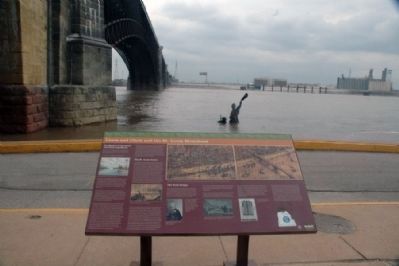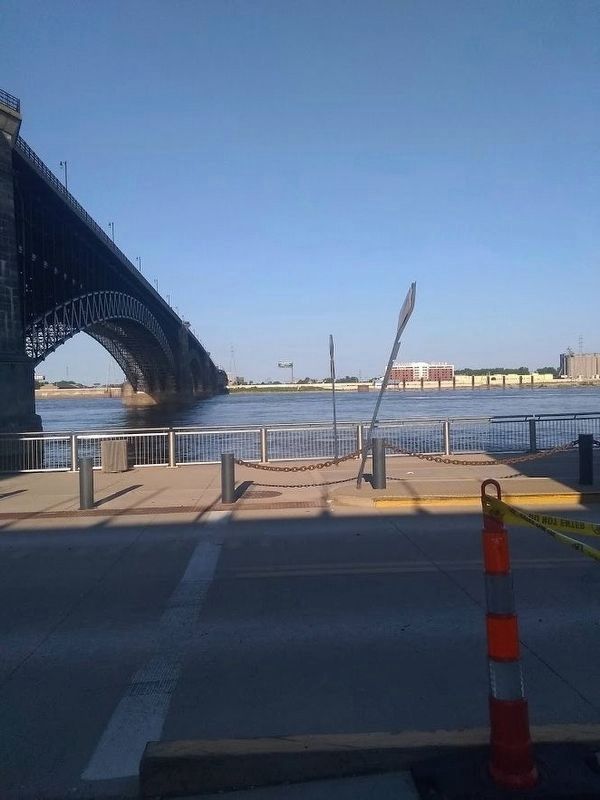Lewis and Clark and St. Louis Riverfront
The Return of the Lewis and Clark Expedition
Michael Haynes "We Arrived in Sight of St. Louis" At about noon on September 23, 1806, five dugout canoes and a larger boat called the "White Pirogue" rounded the bend of the Mississippi River to the north of where you are standing. The citizens of St. Louis, perhaps numbering as many as 1,500, lined the riverbank atop the natural bluff, cheering and firing guns into the air to welcome back Lewis and Clark's "Corps of Discovery."
After nearly 21/2 years, many in St. Louis had given up the explorers for dead, but in late September reports began to filter overland from the town of St. Charles that Lewis and Clark had returned. Told in advance of their impending arrival, St. Louisans watched as a motley-looking group pulled into shore, dressed mostly in animal skins and looking like "Robinson Crusoes," as a contemporary newspaper phrased it.
The return of the expedition to St. Louis meant different things for different members of the crew. For the soldiers, the return to "civilization" was triumphal and promised rewards of land ,grants and extra pay. For the captains, high public offices and nation's thanks awaited. For Clark's slave, York, the landing meant a return to bondage after the taste of freedom he had enjoyed on the expedition. For the Mandan chief Sheheke
and family, who were on their way to Washington to meet President Jefferson, a new world of Anglo-American politics and warnings of westward expansion signaled the beginnings of great changes for the native cultures and people of the West.As they listened to the cheers of the crowd, Lewis and Clark could count among their achievements strengthening the U.S. claim to the Northwest, spurring the American fur trade, accurately mapping the areas through which they passed, and recording essential data for the use of scientists.
The St. Louis Levee
Lewis and Clark would have had trouble envisioning the growth experienced by St. Louis in the 40 years after their return. The town they saw in 1806 sheltered about 1,500 people; by 1850 St. Louis was a still-growing city of 82,000. In the 1850s the levee you see before you, with its granite paving stones set upright for traction, was the third busiest port in the United States. St. Louis was the premiere city of the West, and the levee was its "front door." Boats moored here moved cargoes and goods along the Missouri River to the west, the Mississippi to the north and south, and down to the Ohio River and markets further east. The port was used by overland emigrants bound for the gold fields of California or to seek "free" lands in the Oregon country. Many bought their supplies in St. Louis, including wagons and
A scene of bustling activity, St. Louis was a major transfer point of goods from one river and city to another. Transporting and storing goods for transfer to other vessels was a lucrative trade employed by many free African Americans in St. Louis. Despite a devastating fire in 1849 that began on a steamboat moored on the levee and spread to destroy a large section of downtown, St. Louis bounced back and by the 1850s was more important than before as a trading center and shipping point for the West. But it was not to last. The Civil War interrupted most commerce along the river, and by the end of the war the railroads had become a more significant shipping mode. The modern Port of St. Louis is the second-largest inland port in the nation, handling 30 million tons of freight each year and extending 70 miles from Grafton, Illinois to Festus, Missouri along both banks of the river.
The Eads Bridge
St. Louis needed a bridge to span the river and bring railroad traffic directly into the city. The railroads represented the new era of technological achievement and manufacture in Gilded Age America. The magnificent bridge you see before you was St. Louis' answer to the problem of the river crossing and an attempt to reclaim railroad
When the Civil War began, Eads was awarded a contract to build seven ironclad steamboats, creating a riverboat navy that made the Union victories at Fort Donelson in 1862 and Vicksburg in 1863 possible.
Eads' greatest and most lasting contribution to the city was the bridge constructed to his design, the first span of the Lower Mississippi River and the world's first arched steel truss bridge.
Work began in 1867, as men labored in caissons 90 feet below the surface of the river to dig the foundations for the piers down to bedrock. Workmen suffered from a strange disease they began to call "the bends," the same problem known to modern ocean divers, in which the failure to equalize a return to normal surface pressures causes nitrogen bubbles to form in the bloodstream. Because the bends baffled physicians of the era,16 workers died.
Eads fought Andrew Carnegie for the type of steel he needed, and traveled to London to get financing. The bridge piers were anchored to the bedrock and the stone work was completed by 1872, when the construction of the steel superstructure began. A total of 4,780,000 pounds of steel and 6,313,550 pounds of wrought iron were used in the bridge, which cost $6,536,730. The bridge was built to be stronger than was required; it was supposed to hold 3,000 pounds per lineal foot, but to this day can carry 5,000. Completed on July 4, 1874, when Gen. William Tecumseh Sherman drove the last spike, a huge parade, festival and fireworks display highlighted St. Louis' hopes for the future.
Erected by Great Rivers Greenway.
Topics and series. This historical marker is listed in these topic lists: Bridges & Viaducts • Exploration • Waterways & Vessels. In addition, it is included in the Former U.S. Presidents: #03 Thomas Jefferson, and the Lewis & Clark Expedition series lists. A significant historical date for this entry is July 4, 1874.
Location. Marker has been reported missing. It was located near 38° 37.74′ N, 90° 10.932′ W. Marker was in St. Louis, Missouri. It was in Downtown. Marker was at the intersection of N Leonor K Sullivan Blvd. and Washington Ave., on the left when traveling south on N Leonor K Sullivan Blvd.. Marker was next to the Eads Bridge and near the northeast corner of the Gateway Arch National Park. Touch for map. Marker was in this post office area: Saint Louis MO 63102, United States of America. Touch for directions.
Other nearby markers. At least 8 other markers are within walking distance of this location. The James B. Eads Bridge (within shouting distance of this marker); In Memory of Katherine Ward Burg (about 400 feet away, measured in a direct line); Rue Royale (about 500 feet away); Gateway to the West (about 700 feet away); Old Missouri Hotel (about 700 feet away); Action and Reaction (about 700 feet away); La Grande Rue (about 700 feet away); The Captains' Return (approx. 0.2 miles away). Touch for a list and map of all markers in St. Louis.
More about this marker. Marker has been reported missing. It is not known if it was stolen, or intentionally removed during the redevelopments of the Gateway Arch National Park period from 2014 to 2018. Leonor K. Sullivan Boulevard and the accompanying trail were repaved during that time; also, trails and grassy areas replaced old nearby parking garages. It was also in an area where, like most nearby markers on Leanor K. Sullivan Boulevard, flooding frequently occurred especially in recent years.
Credits. This page was last revised on January 30, 2023. It was originally submitted on March 11, 2011, by Juris Bets of Des Moines, Iowa. This page has been viewed 1,631 times since then and 45 times this year. Last updated on June 15, 2020, by Jason Voigt of Glen Carbon, Illinois. Photos: 1. submitted on March 11, 2011, by Juris Bets of Des Moines, Iowa. 2. submitted on June 16, 2020, by Jason Voigt of Glen Carbon, Illinois. • Devry Becker Jones was the editor who published this page.

